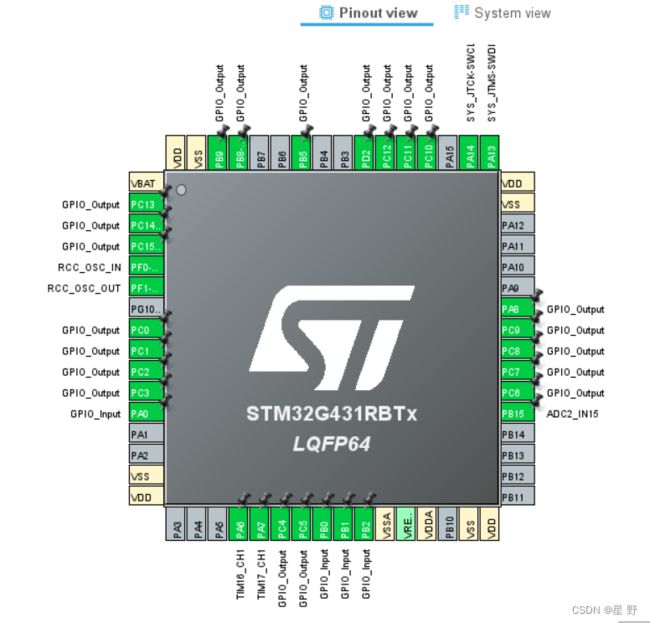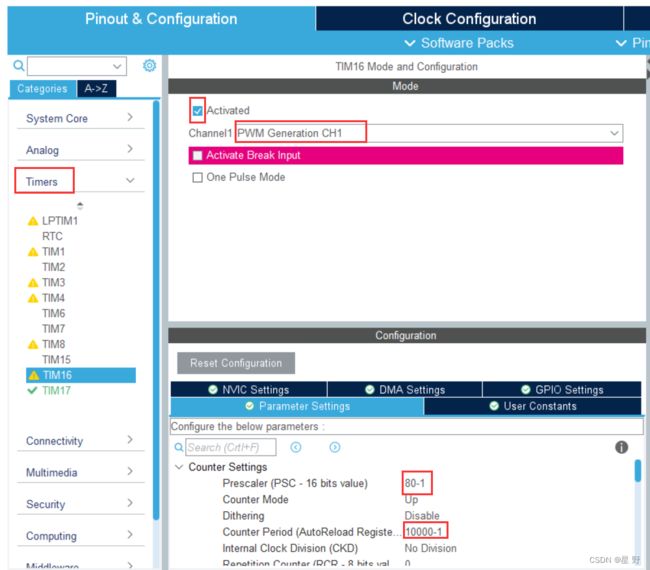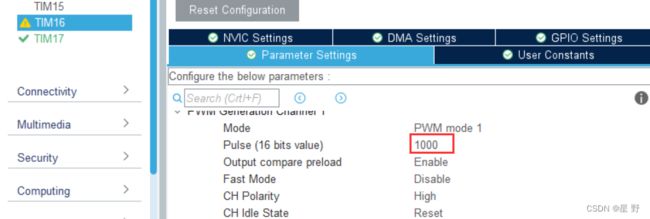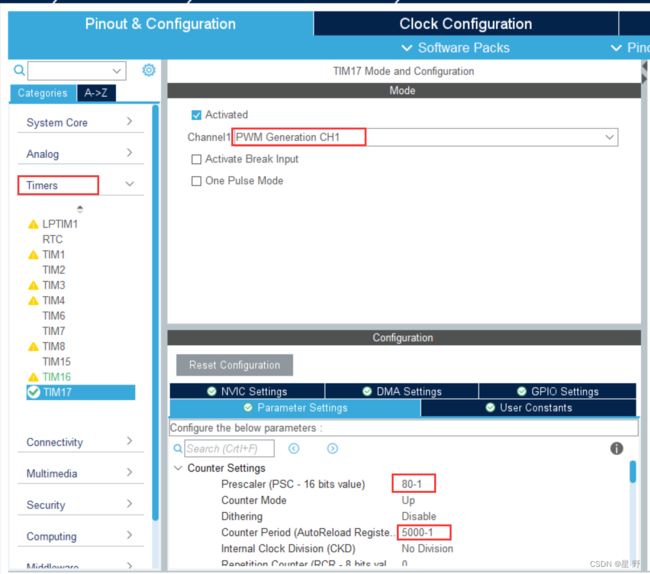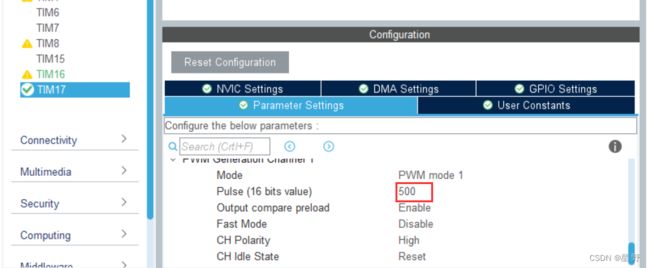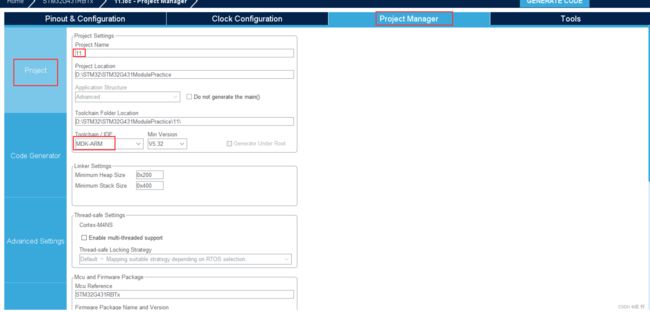蓝桥杯嵌入式第十一届省赛题目解析
写完第十一届蓝桥杯嵌入式省赛题目,拿出来给大家参考参考,也是让大家一起测试看看有什么问题还需要改进,代码在最后喔。
目录
客观题:
程序设计题 :
题目解析:
CubeMX配置
代码演示 :
客观题:
收集的一些历年的比赛客观题和解析,以及程序设计题的PDF,在这里分享给大家。
链接:https://pan.baidu.com/s/1hTw0inSbLjX57hOtankgKw
程序设计题 :
题目解析:
说一下,十一届用的是f103的开发板,本人是用g431来解题目。此次程序设计题用到的模块是LCD,LED,按键,ADC和两个PWM,模块也都是常考的,熟悉的话没什么问题。
其中PWM就需要改占空比,那么可以使用一个用来改变PWM占空比的函数。
//修改PWM的占空比(CCRX)
__HAL_TIM_SET_COMPARE(&htim16, TIM_CHANNEL_1, PA6*100);
注意:函数的参数是根据自动重装载值来设置的,例如题目是要求PA6引脚可以根据按键来修改占空比从10%到90%,由于我设置的自动重装载值是10000,所以当我们需要将占空比设置为10%时,变量PA6=10,传过去的参数是1000,而1000就是10000的10%
而ADC主要是获取到ADC的值并转换成电压值。
float Get_ADC(ADC_HandleTypeDef *pin)
{
uint adc;
HAL_ADC_Start(pin);
adc = HAL_ADC_GetValue(pin);
return adc*3.3/4096;
}说完了,就开始配置CubeMX吧,
CubeMX配置
![]()
![]()
![]()
时钟配置完了,需要按下回车(Enter)来保存。
根据原理图配置GPIO引脚,其中lcd和led的引脚都设置为output,按键设置为input,PWM1是PA6设置为定时器16的第一通道,PWM2是PA7设置为定时器17的第一通道,需要把PD2也设置为output用来作为led的锁存器。
![]()
在GPIO中选中按键的引脚,设置为上拉输入模式。
![]()
在GPIO中,选中led的引脚,设置为初始状态为高电平(上电是LED灯就是熄灭状态),推挽输出模式,既不上拉也不下拉。其他引脚使用默认设置就是行。
定时器16的通道1设置为PWM1的通道1,然后设置预分频器值和自动重装值以及占空比,初始状态占空比10%。
定时器17的通道1设置为PWM2的通道1,然后设置预分频器值和自动重装值以及占空比,初始状态占空比10%。
勾选ADC2的第15通道,其他默认就行。
设置项目名字和保存路径(建议不要有中文),以及IDE的版本。
![]()
勾选这个主要是让.c和.h文件单独分开,之后就可以生成代码了,CubeMX配置就完成了,如果之后想要添加新的模块或者修改配置好了模块的值,可以直接在文件中打开CubeMX的工程进行修改,改完后再点击GENERATE CODE就行了。
代码演示 :
main.c
/* USER CODE BEGIN Header */
/**
******************************************************************************
* @file : main.c
* @brief : Main program body
******************************************************************************
* @attention
*
* Copyright (c) 2023 STMicroelectronics.
* All rights reserved.
*
* This software is licensed under terms that can be found in the LICENSE file
* in the root directory of this software component.
* If no LICENSE file comes with this software, it is provided AS-IS.
*
******************************************************************************
*/
/* USER CODE END Header */
/* Includes ------------------------------------------------------------------*/
#include "main.h"
#include "adc.h"
#include "tim.h"
#include "gpio.h"
/* Private includes ----------------------------------------------------------*/
/* USER CODE BEGIN Includes */
#include "led.h"
#include "key.h"
#include "show.h"
#include "lcd.h"
#include "mst.h"
/* USER CODE END Includes */
/* Private typedef -----------------------------------------------------------*/
/* USER CODE BEGIN PTD */
/* USER CODE END PTD */
/* Private define ------------------------------------------------------------*/
/* USER CODE BEGIN PD */
/* USER CODE END PD */
/* Private macro -------------------------------------------------------------*/
/* USER CODE BEGIN PM */
/* USER CODE END PM */
/* Private variables ---------------------------------------------------------*/
/* USER CODE BEGIN PV */
extern uchar btn; //按键值
extern bool L1,L2; //LED1和LED2的标识,为1点亮
uchar PA6 = 10,PA7 = 10; //PA6,PA7的占空比
bool mode = 0,jm = 0; //mode为0是自动模式,jm为0是数据显示界面
float ADC = 0.0f;
/* USER CODE END PV */
/* Private function prototypes -----------------------------------------------*/
void SystemClock_Config(void);
/* USER CODE BEGIN PFP */
/* USER CODE END PFP */
/* Private user code ---------------------------------------------------------*/
/* USER CODE BEGIN 0 */
/* USER CODE END 0 */
/**
* @brief The application entry point.
* @retval int
*/
int main(void)
{
/* USER CODE BEGIN 1 */
/* USER CODE END 1 */
/* MCU Configuration--------------------------------------------------------*/
/* Reset of all peripherals, Initializes the Flash interface and the Systick. */
HAL_Init();
/* USER CODE BEGIN Init */
/* USER CODE END Init */
/* Configure the system clock */
SystemClock_Config();
/* USER CODE BEGIN SysInit */
/* USER CODE END SysInit */
/* Initialize all configured peripherals */
MX_GPIO_Init();
MX_TIM16_Init();
MX_TIM17_Init();
MX_ADC2_Init();
/* USER CODE BEGIN 2 */
LCD_Init();
LCD_Clear(Black);
LCD_SetBackColor(Black);
LCD_SetTextColor(White);
HAL_TIM_PWM_Start(&htim16, TIM_CHANNEL_1);
HAL_TIM_PWM_Start(&htim17, TIM_CHANNEL_1);
/* USER CODE END 2 */
/* Infinite loop */
/* USER CODE BEGIN WHILE */
while (1)
{
/* USER CODE END WHILE */
/* USER CODE BEGIN 3 */
ADC = Get_ADC(&hadc2);
KEY_Scan();
switch(btn)
{
case 1:
{
jm ^= 1;
L2 ^= 1;
btn = 0;
LCD_Clear(Black);
}
break;
case 2:
{
if(1 == jm)
{
PA6 += 10;
if(PA6 > 90)
PA6 = 10;
}
btn = 0;
}
break;
case 3:
{
if(1 == jm)
{
PA7 += 10;
if(PA7 > 90)
PA7 = 10;
}
btn = 0;
}
break;
case 4:
{
mode ^= 1;
L1 ^= 1;
btn = 0;
LCD_Clear(Black);
}
break;
}
if(0 == jm)
Data();
else
Para();
if(0 == mode)
{
PWM_Set_Compare(&htim16, (uchar)(ADC/3.3f)*10000); //设置占空比,把_HAL_TIM_SET_COMPARE函数封装了一下,在show.c中
PWM_Set_Compare(&htim17, (uchar)(ADC/3.3f)*5000);
}
else
{
PWM_Set_Compare(&htim16, PA6*100);
PWM_Set_Compare(&htim17, PA7*50);
}
LED_Hint();
}
/* USER CODE END 3 */
}
/**
* @brief System Clock Configuration
* @retval None
*/
void SystemClock_Config(void)
{
RCC_OscInitTypeDef RCC_OscInitStruct = {0};
RCC_ClkInitTypeDef RCC_ClkInitStruct = {0};
/** Configure the main internal regulator output voltage
*/
HAL_PWREx_ControlVoltageScaling(PWR_REGULATOR_VOLTAGE_SCALE1);
/** Initializes the RCC Oscillators according to the specified parameters
* in the RCC_OscInitTypeDef structure.
*/
RCC_OscInitStruct.OscillatorType = RCC_OSCILLATORTYPE_HSE;
RCC_OscInitStruct.HSEState = RCC_HSE_ON;
RCC_OscInitStruct.PLL.PLLState = RCC_PLL_ON;
RCC_OscInitStruct.PLL.PLLSource = RCC_PLLSOURCE_HSE;
RCC_OscInitStruct.PLL.PLLM = RCC_PLLM_DIV3;
RCC_OscInitStruct.PLL.PLLN = 20;
RCC_OscInitStruct.PLL.PLLP = RCC_PLLP_DIV2;
RCC_OscInitStruct.PLL.PLLQ = RCC_PLLQ_DIV2;
RCC_OscInitStruct.PLL.PLLR = RCC_PLLR_DIV2;
if (HAL_RCC_OscConfig(&RCC_OscInitStruct) != HAL_OK)
{
Error_Handler();
}
/** Initializes the CPU, AHB and APB buses clocks
*/
RCC_ClkInitStruct.ClockType = RCC_CLOCKTYPE_HCLK|RCC_CLOCKTYPE_SYSCLK
|RCC_CLOCKTYPE_PCLK1|RCC_CLOCKTYPE_PCLK2;
RCC_ClkInitStruct.SYSCLKSource = RCC_SYSCLKSOURCE_PLLCLK;
RCC_ClkInitStruct.AHBCLKDivider = RCC_SYSCLK_DIV1;
RCC_ClkInitStruct.APB1CLKDivider = RCC_HCLK_DIV1;
RCC_ClkInitStruct.APB2CLKDivider = RCC_HCLK_DIV1;
if (HAL_RCC_ClockConfig(&RCC_ClkInitStruct, FLASH_LATENCY_2) != HAL_OK)
{
Error_Handler();
}
}
/* USER CODE BEGIN 4 */
/* USER CODE END 4 */
/**
* @brief This function is executed in case of error occurrence.
* @retval None
*/
void Error_Handler(void)
{
/* USER CODE BEGIN Error_Handler_Debug */
/* User can add his own implementation to report the HAL error return state */
__disable_irq();
while (1)
{
}
/* USER CODE END Error_Handler_Debug */
}
#ifdef USE_FULL_ASSERT
/**
* @brief Reports the name of the source file and the source line number
* where the assert_param error has occurred.
* @param file: pointer to the source file name
* @param line: assert_param error line source number
* @retval None
*/
void assert_failed(uint8_t *file, uint32_t line)
{
/* USER CODE BEGIN 6 */
/* User can add his own implementation to report the file name and line number,
ex: printf("Wrong parameters value: file %s on line %d\r\n", file, line) */
/* USER CODE END 6 */
}
#endif /* USE_FULL_ASSERT */
main.h
/* USER CODE BEGIN Header */
/**
******************************************************************************
* @file : main.h
* @brief : Header for main.c file.
* This file contains the common defines of the application.
******************************************************************************
* @attention
*
* Copyright (c) 2023 STMicroelectronics.
* All rights reserved.
*
* This software is licensed under terms that can be found in the LICENSE file
* in the root directory of this software component.
* If no LICENSE file comes with this software, it is provided AS-IS.
*
******************************************************************************
*/
/* USER CODE END Header */
/* Define to prevent recursive inclusion -------------------------------------*/
#ifndef __MAIN_H
#define __MAIN_H
#ifdef __cplusplus
extern "C" {
#endif
/* Includes ------------------------------------------------------------------*/
#include "stm32g4xx_hal.h"
/* Private includes ----------------------------------------------------------*/
/* USER CODE BEGIN Includes */
#include
#include
#include
/* USER CODE END Includes */
/* Exported types ------------------------------------------------------------*/
/* USER CODE BEGIN ET */
/* USER CODE END ET */
/* Exported constants --------------------------------------------------------*/
/* USER CODE BEGIN EC */
/* USER CODE END EC */
/* Exported macro ------------------------------------------------------------*/
/* USER CODE BEGIN EM */
/* USER CODE END EM */
/* Exported functions prototypes ---------------------------------------------*/
void Error_Handler(void);
/* USER CODE BEGIN EFP */
/* USER CODE END EFP */
/* Private defines -----------------------------------------------------------*/
/* USER CODE BEGIN Private defines */
#define uchar unsigned char
#define uint unsigned int
/* USER CODE END Private defines */
#ifdef __cplusplus
}
#endif
#endif /* __MAIN_H */
key.c
#include "key.h"
Btn key[4] = {0};
uchar btn = 0;
void KEY_Scan(void)
{
uchar i;
key[0].press = HAL_GPIO_ReadPin(GPIOB, GPIO_PIN_0);
key[1].press = HAL_GPIO_ReadPin(GPIOB, GPIO_PIN_1);
key[2].press = HAL_GPIO_ReadPin(GPIOB, GPIO_PIN_2);
key[3].press = HAL_GPIO_ReadPin(GPIOA, GPIO_PIN_0);
for(i=0;i<4;i++)
{
switch(key[i].state)
{
case 0:
if(key[i].press == 0)
key[i].state = 1;
break;
case 1:
{
if(key[i].press == 0)
{
key[i].state = 2;
btn = i+1;
}
else
key[i].state = 0;
}
break;
case 2:
if(key[i].press == 1)
key[i].state = 0;
break;
}
}
}key.h
#ifndef __KEY_H
#define __KEY_H
#include "main.h"
typedef struct{
bool press;
uchar state;
}Btn;
void KEY_Scan(void);
#endif
led.c
#include "led.h"
uint16_t LED = 0xff00;
bool L1 = 1,L2 = 1;
void LED_SET(void)
{
GPIOC->ODR = LED;
HAL_GPIO_WritePin(GPIOD, GPIO_PIN_2, GPIO_PIN_SET);
HAL_GPIO_WritePin(GPIOD, GPIO_PIN_2, GPIO_PIN_RESET);
}
void LED_Hint(void)
{
if(1 == L1)
{
LED &= ~(0x01ff);
LED_SET();
}
else
{
LED |= 0x0100;
LED_SET();
}
if(1 == L2)
{
LED &= ~(0x02ff);
LED_SET();
}
else
{
LED |= 0x0200;
LED_SET();
}
}
led.h
#ifndef __LED_H
#define __LED_H
#include "main.h"
void LED_SET(void);
void LED_Hint(void);
#endif
led使用寄存器,目的是单独控制一个LED灯时不干扰其他LED灯,使用HAL库函数,改变一个灯的值,会干扰到其他灯的显示,有没有好心人在评论区告知一下怎么使用HAL库才不会有这种情况,感谢。
show.c
#include "show.h"
extern uchar PA6,PA7;
extern bool mode;
char text[21];
void LCD_SHOW(u8 line, char *text)
{
LCD_DisplayStringLine(line*24, (u8 *)text);
}
void Data(void)
{
sprintf(text, " Data ");
LCD_SHOW(0, text);
sprintf(text, " V:%.2fV ",Get_ADC(&hadc2));
LCD_SHOW(2, text);
if(!mode)
sprintf(text, " Mode:AUTO ");
else
sprintf(text, " Mode:MANU ");
LCD_SHOW(4, text);
}
void Para(void)
{
sprintf(text, " Para ");
LCD_SHOW(0, text);
sprintf(text, " PA6:%d%% ",PA6);
LCD_SHOW(2, text);
sprintf(text, " PA7:%d%% ",PA7);
LCD_SHOW(4, text);
}
void PWM_Set_Compare(TIM_HandleTypeDef *htim, uchar Duty)
{
__HAL_TIM_SET_COMPARE(htim, TIM_CHANNEL_1, Duty);
}
show.h
#ifndef __SHOW_H
#define __SHOW_H
#include "main.h"
#include "lcd.h"
#include "adc.h"
#include "mst.h"
#include "tim.h"
void LCD_SHOW(u8 line, char *text);
void Data(void);
void Para(void);
void PWM_Set_Compare(TIM_HandleTypeDef *htim, uchar Duty);
#endif
mst.c
#include "mst.h"
float Get_ADC(ADC_HandleTypeDef *pin)
{
uint adc;
HAL_ADC_Start(pin);
adc = HAL_ADC_GetValue(pin);
return adc*3.3/4096;
}
mst.h
#ifndef __MST_H
#define __MST_H
#include "main.h"
float Get_ADC(ADC_HandleTypeDef *pin);
#endif
以上就是我修改过的文件和新添加的文件。还有lcd模块,不过不需要我们自己写,官方有提供,直接复制过来就行,注意有三个文件,别只复制lcd.c和lcd.h。
![]()
![]()
总的来说,这届题目是比较简单的,用到的模块和逻辑都没有什么难度。好了,以上就是蓝桥杯嵌入式第十一届省赛的题目解析了,如果有什么问题和建议都欢迎在评论区提出来喔。


